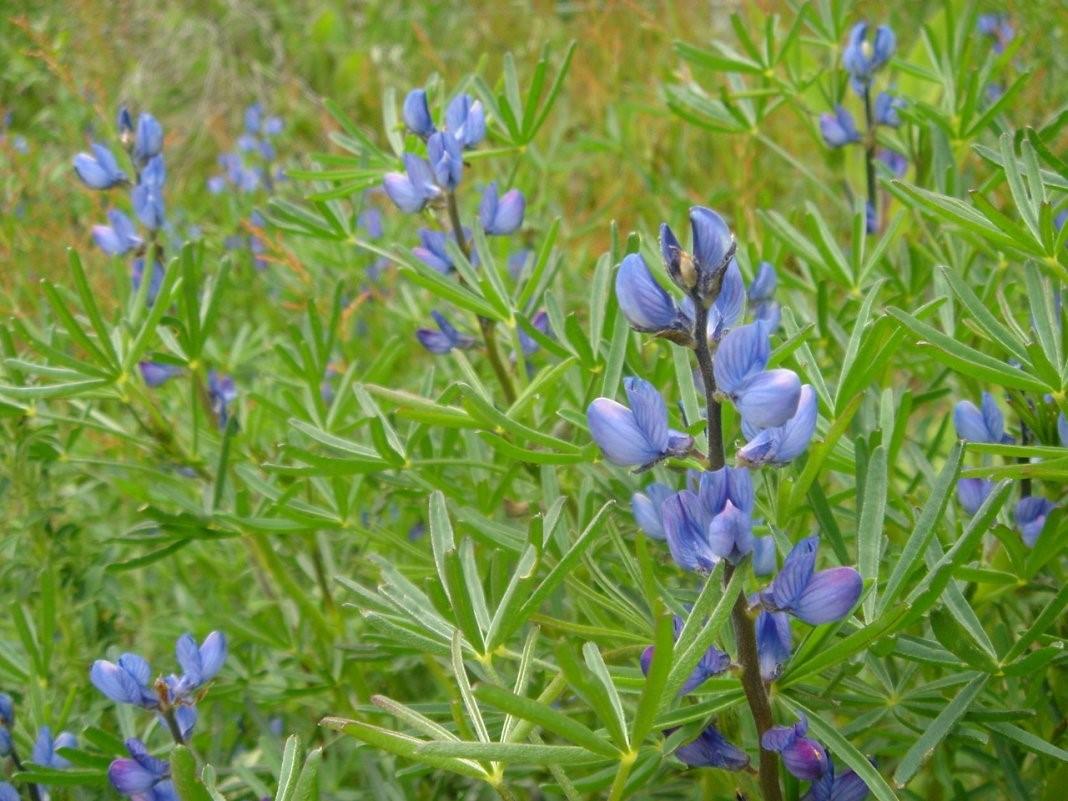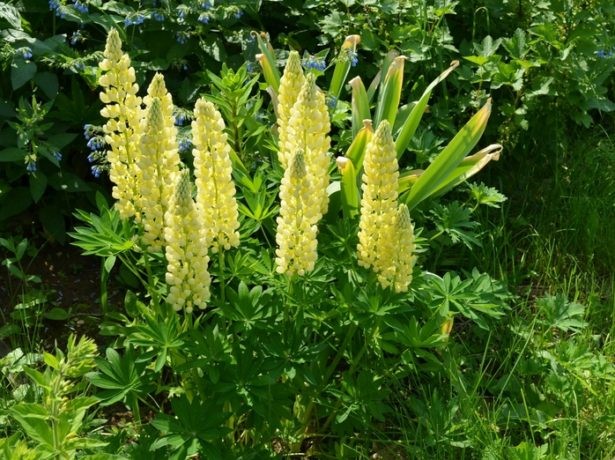Content
- 1 Types of lupine
- 2 Advantages and disadvantages of lupine as green manure
- 3 On what soils is it used?
- 4 For which crops is it suitable?
- 5 When to sow lupine as green manure
- 6 How to sow lupine for green manure
- 7 How quickly does lupine green manure grow?
- 8 Care instructions
- 9 Diseases and pests
- 10 How to use lupine as green manure
- 11 Conclusion
- 12 Reviews on the use of lupine as green manure
Lupine as a green manure is suitable for almost all plants. It produces deep roots that perfectly loosen the soil. It is resistant to drought and low maintenance. However, it is better to sow seeds in fertile soil. How and when to do this is described in detail in the presented article.
Types of lupine
Gardeners know several types of lupine. Some are grown as green manure, and some representatives are also grown as ornamental plants. Among the most common varieties are the following:
- White lupine can be used as green manure in a flower bed, but more often it is used as an ornamental plant. It requires some care, but can also be used as a top dressing. It grows in height up to 2 m, inflorescences up to 30 cm. The plant is heat-loving, but at the same time drought-resistant. Common varieties are Degas and Gamma.
- Yellow - this lupine as a green manure grows up to 1 m, often less.It is not self-pollinating, so it always needs bees and other pollinators. The name reflects the color of the inflorescences, which can be yellow or orange. Grows well on sandy and sandy loam soils. Common varieties are Peresvet, Fakel and Grodnensky 3.
- For planting, green manure such as blue lupine (also known as narrow-leaved lupine) is also used. The plant tolerates frost quite well and is unpretentious in care. The color comes in both blue and other shades, such as pink, lilac and white. It reaches a height of 1.5 m. Common varieties are Nemchinovsky blue, Crystal, Siderat 38 and Smena.
- Hartwega is another variety of lupine, used as green manure and an ornamental plant. Reaches a height of 50-60 cm. Produces straight branched stems with blue and pink flowers. Most often it is grown as an annual, although in the south of Russia it can also be grown as a perennial crop.
Advantages and disadvantages of lupine as green manure
Lupine is used as green manure for several reasons. This culture has many advantages:
- The plant produces a very deep root, which penetrates up to 1.5-2 m. This allows you to extract nutrients even from distant layers of soil and enrich the surface layer (after digging and chopping the plants).
- One of the main functions of lupine as a green manure is to supply the soil with oxygen. It reaches the roots along with air and ensures rapid growth.
- Almost all varieties of lupine contain alkaloids, due to which they have a good effect on acidic soil, leveling the balance.
- Lupine grows very quickly. In just 1.5 months you can get a full-fledged harvest, mow it and chop it, embedding it in the soil.
- The green mass of the plant is used as a natural fertilizer.Thanks to this, productivity increases significantly.
- Lupine as a green manure and ornamental crop is unpretentious. It survives almost as well as many weeds. It tolerates short-term frosts and drought well and does not require special care.
- There is another significant plus - lupine green manure repels pests quite well and blocks the growth of weeds. For this reason, it is often planted between rows, next to the main crop plantings.
However, there are also some disadvantages:
- The plant does not tolerate shade quite well - it cannot be planted in all areas.
- Seeds are consumed in large quantities - the sowing rate of lupine for green manure corresponds to 3 kg per 1 hundred square meters, i.e. 30 g per 1 m2.
- Since not all varieties are frost-resistant, planting must be planned for the second half of spring. In Siberia, the Urals and the Far East, work begins only in early May.
- Another disadvantage is associated with the plant’s demands on the composition of the soil. Green manure seeds germinate quickly only on fertilized soils.

Lupine grows well on sandy loam
On what soils is it used?
Sowing lupins on green manure can be planned on almost any soil, since the plant is unpretentious. But the following types of soil are best suited for it:
- sandy loam;
- loamy;
- sandy
The first two options are optimal, since the soil is moderately dense, quite loose and fertile. The soil particles are distributed evenly and allow the maximum amount of air to pass through. Thanks to this, the roots absorb oxygen, metabolic processes proceed normally, and growth rates are quite high.
You can sow lupine in the spring as green manure on sandy soil. But it is worth considering that the soil is very loose and loose.It quickly absorbs moisture, although it gives it away just as quickly. Therefore, it is important to water more often; you can mulch with straw, hay or other materials. During preliminary preparation, it is recommended to embed 1-2 kg of crushed clay per 1 m into the soil2.
Clay soil is not at all suitable for lupine as green manure. It is quite heavy, takes a long time to dry, and does not allow oxygen to pass through well. Because of this, the roots can suffer and even rot. Therefore, before planting, it is advisable to carefully dig up the area and add sawdust or coarse sand in the amount of 2-3 kg per square meter.
For which crops is it suitable?
Lupine can be used as green manure for a wide variety of crops, for example, for nightshades:
- potato;
- eggplant;
- peppers;
- tomatoes.
Lupine goes especially well with crops that take a long time to mature. These can be late varieties of potatoes, parsnips, pumpkin. It is quite acceptable to plant green manure before planting cruciferous vegetables - different varieties of cabbage, radishes and radishes.
When to sow lupine as green manure
First of all, it is important to decide when to sow and bury lupine green manure. There are two main periods for planting crops - spring and autumn. Most often the second option is chosen. Moreover, sowing is planned for the middle or second half of August - immediately after the field is cleared of the main crop.

The best time for sowing lupine is autumn
There is another approach when the seeds are sown before winter. The calculation is made that green manure lupine will sprout in April and produce a harvest in May.However, this method may not be suitable for very frosty regions.
In the spring, you should start planting lupine green manure after the snow has completely melted and the soil has warmed up sufficiently. In most regions, work begins in the middle or second half of April.
How to sow lupine for green manure
When planting green manure seeds, proceed as follows:
- Pre-prepare the soil, clean the area, and level the surface.
- Several furrows with a depth of no more than 4-5 cm are formed at intervals of 20-30 cm.
- Distribute the seeds evenly at a distance of 6-7 cm from each other. Comply with the consumption rate of up to 3 kg per hundred square meters.
- Water with settled water, being careful not to get it on the grooves themselves (it is better to pour between the rows).
How quickly does lupine green manure grow?
Lupine green manure grows well only if several conditions are met:
- good lighting;
- fertile soil;
- no night frosts.
If the weather is favorable, seedlings appear within 10-14 days. Lupine grows quickly, and soon the seedlings produce their first leaves. As soon as 2-3 of them appear, you need to start thinning. The procedure is carried out so that as a result there is 30-40 cm between neighboring plants.
Care instructions
To get a fairly large harvest of lupine green manure, you should follow certain care rules, especially in terms of watering and fertilizing:
- Water is given only in cases when dry weather has occurred. Many varieties are heat tolerant, but it is best to keep the soil moderately moist.
- Fertilizing should be done twice - a few days after thinning, and then after another 2-3 weeks. It is recommended to give complex fertilizers, for example, “Kemira Lux” or “Agricola”.
- While the green manure lupine is sprouting, monitor the germination of weeds. If necessary, do weeding.

Lupine is best grown in open areas
Diseases and pests
Lupine green manure is resistant to some diseases, but can suffer from fungal infections such as fusarium, rust or rot. Viral mosaic infection is also possible. In this case, all plantings will have to be destroyed and the soil disinfected. If plants suffer from fungal infections, they should be treated once with a fungicide:
- "Profit";
- "Ordan";
- "Abiga Peak".
Among insects, aphids are dangerous. Insecticide treatments will help you cope with the invasion:
- "Decis";
- "Fufanon";
- "Vertimek".
How to use lupine as green manure
The basic rule of application is to mow the plant 60 days after planting, i.e. approximately 1.5 months after germination. Moreover, it is important to periodically inspect the plants. Work can begin after flowering has completed and small green pods have appeared.
The tops are mowed very low, it is advisable to cut the roots with a flat cutter. The green mass is crushed with a shovel, then evenly spread over the surface. The most massive stems are removed by hand - they can be used for compost. Then they are watered and left to lie down for two weeks, after which they are embedded in the ground to a shallow depth of up to 10 cm.
Conclusion
Lupine as a green manure is used quite often, since the plant gives a good harvest and also takes root in different climatic conditions. It is best to plant seeds in late summer or late autumn before winter.But since the growth rate is high, work can be planned for mid-spring. In any case, digging and embedding into the soil is carried out only 60 days after planting.
Reviews on the use of lupine as green manure











